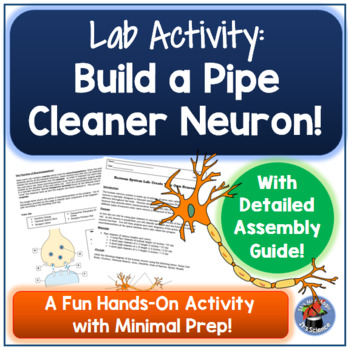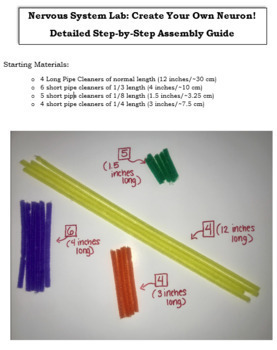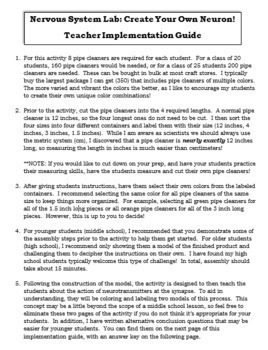Build a Pipe Cleaner Neuron Lab Activity
- Zip
What educators are saying
Also included in
- Bundle DescriptionThis bundle includes everything you need to teach about the human nervous system, most specifically the nerve cell! Begin with a lesson on the structure and function of the nerve cell and then reinforce the new content with a hands-on activity in which students will build their vePrice $7.20Original Price $9.00Save $1.80
- This is a custom bundle designed specifically for one educator. Feel free to purchase this bundle for yourself, or if you would like to request your own custom bundle you can email me at kbruno1211@gmail.com. Products Included in this Bundle:Full Year Biology Big Bundle!Human Body Systems Big BundPrice $125.00Original Price $172.74Save $47.74
Description
In this activity, students will build their own model of a human nerve cell using pipe cleaners of various lengths. It is a perfect supplement to an introductory lesson on the structure of a nerve cell and how that structure directly influences its function. This activity in its entirety was designed for a high school biology or anatomy class, but can be modified for use in a middle school general science class by simply eliminating several pages of the student activity handout. It can also be excellent for a high school psychology course covering the biological basis of behavior. I have been doing this activity for many years, and it is always a student favorite!
In total it takes about 15-20 minutes for students to create the “pipe cleaner neuron” and another 15-30 minutes for students to complete the supplemental questions, depending on the level of your class. Following the construction of the pipe cleaner neuron, students will color and label the structures and components of a synapse, including neurotransmitters, receptor proteins, vesicles, and reuptake proteins. The entire activity can be completed in a 40 minute lesson, with materials prepared ahead of time and students possibly answering the final analysis questions for homework. Of course as a final bonus, the students may keep their neuron!
Required Materials:
-Pipe Cleaners (8 per student). These can be bought in bulk very cheaply from most craft stores (I buy packages with as many as 350 pipe cleaners of various colors, which is enough for approximately 45 students). To cut down on cost you can have students build their neurons in pairs of two.
-Colored Pencils
Teacher Tips:
I find it easiest to pre-cut the pipe cleaners into the various lengths prior to the activity and then allow students to choose their colors. However, if you would like to lengthen the activity time, and present your students with an additional challenge, you can provide your students with rulers and scissors and they can measure and cut the pipe cleaners themselves. You also may choose to demonstrate the assembly of the model prior to students building their own (better for younger students), or challenge your students to follow the instructions on their own (great for an honors or accelerated class).
Included in the Zip File:
Pipe Cleaner Neuron Student Activity Handout
Full Teacher Answer Key
Detailed Implementation Guide
Step-by-Step Assembly Instructions (Including Photos)
Check Out My Related Products!
Human Nervous System Guided Notes and PowerPoint







